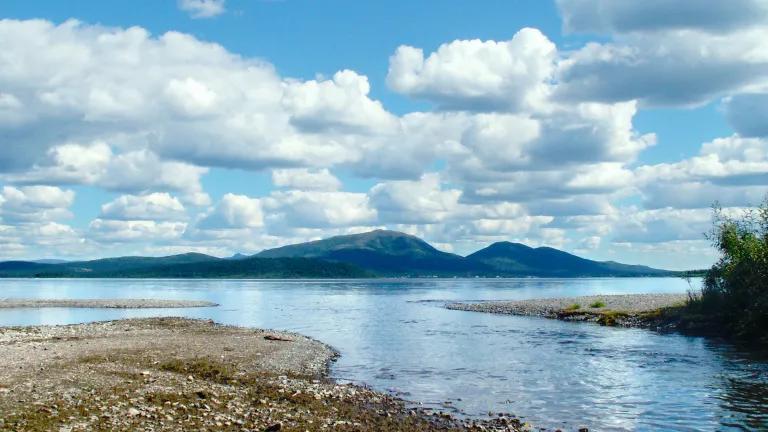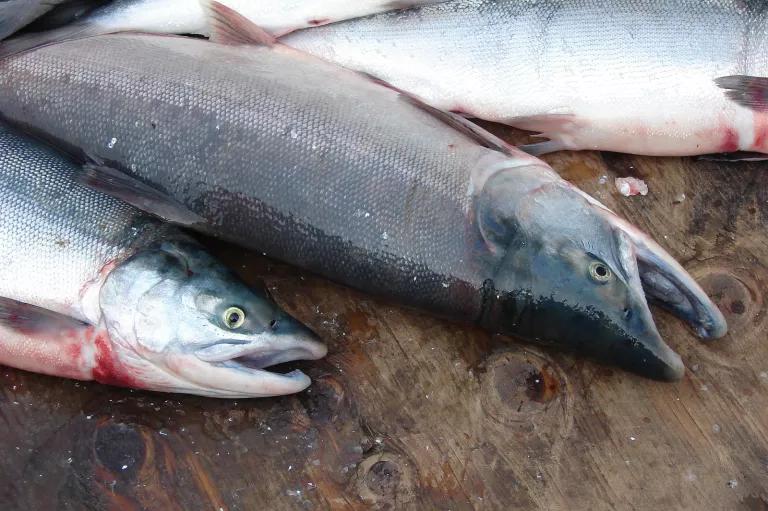Crushing Alaska’s Pebble Mine
The EPA’s decision to veto the project is fantastic news—but the fight to save Bristol Bay isn’t over yet.

Friends of Bristol Bay via Flickr, CC BY-NC 4.0
Creating a massive open-pit gold and copper mine near the world’s largest salmon fishery has always been a terrible idea. And ever since the Pebble Mine project in Bristol Bay, Alaska, was first proposed more than 20 years ago, a broad coalition made up of local residents, tribal members, commercial fishers, hunters, and environmental groups—including NRDC—has been saying so.
On January 30, the U.S. Environmental Protection Agency (EPA) officially agreed. Citing a provision of the Clean Water Act, the EPA effectively vetoed the project, putting the mine’s future in serious jeopardy and simultaneously striking a blow for clean water, healthy fisheries, and the cultural heritage of Alaska’s Indigenous peoples.
EPA: Bristol Bay is a “one-of-a-kind ecosystem”
In explaining the rationale behind the agency’s decision, Radhika Fox, the EPA’s assistant administrator for water, said that the mine’s discharges of various pollutants—including cyanide, heavy metals, and toxic chemicals—would “have unacceptable and adverse effects on certain salmon fishery areas in the Bristol Bay watershed.” Fox’s boss, EPA Administrator Michael Regan, noted that the watershed is a crucial source of jobs, food, and cultural significance for people living in this remote region. “With this action,” he said, “EPA is advancing its commitment to help protect this one-of-a-kind ecosystem, safeguard an essential Alaskan industry, and preserve the way of life for more than two dozen Alaska Native villages.”
The Bristol Bay watershed rests about 200 miles southwest of Anchorage, Alaska’s largest city. Crisscrossed by rivers and dotted with lakes, the region’s 40,000 square miles of wild tundra and wetlands are reachable only by plane—and as a consequence, they remain virtually pristine. The many waterways here support subsistence hunters, fishing tourism, and a diverse array of wildlife. Along with grizzly bears and bald eagles, the area boasts the world’s most productive salmon run, where a low average of 30 million to 50 million fish return every summer to spawn. In fact, the Bristol Bay fishery supplies more than half of all sockeye salmon sold on the global market.
News of the EPA’s recent decision prompted Joel Reynolds, NRDC’s western director and a senior attorney in its Nature program, to note that the long-standing battle over the Pebble Mine has “pitted an essentially eternal supply of food against an essentially eternal threat of irreparable harm—and today, the planet won.”
Pebble Mine was a bad investment—for everyone
In 2001, Northern Dynasty Minerals, a small Canadian company, proposed the project on 186 square miles of Alaska state land for which it held the mineral rights. Lacking mining experience of its own, Northern Dynasty sought help. So three of the world’s largest companies—Anglo American, Mitsubishi, and Rio Tinto—quickly jumped on board, all eager for a piece of the estimated $350 billion worth of precious metals beneath the landscape. The four companies started planning what could be, at two miles wide and 2,000 feet deep, the largest open-pit mine in North America.
Why so big? Due to the region’s remote location and the low-grade quality of its minerals, making a buck wasn’t going to come easy. To extract just one pound of ore, the miners would have had to sift through 99 pounds of rock. Pebble Mine would be worth the investment only if it were made as big as possible, turning a bad idea into a catastrophically bad idea.
The chemicals the miners would have used to separate the gold and copper deposits from the rock would have created an unimaginable amount of toxic waste. The project would have required earthen dams as tall as 545 feet in order to keep 10 billion tons of mine tailings from the surrounding environment—forever. Dams leak; that’s no secret. But they are especially vulnerable in wet and earthquake-prone regions like Bristol Bay. According to a 2014 EPA report, the mine would have had the potential to destroy 94 miles of streams and 5,350 acres of wetlands, ponds, and lakes. It would also have removed an extra 35 billion gallons of fresh water from salmon habitat every year. And all that damage would come from only the mine itself.
Mines don’t exist in a vacuum
Pebble Mine would have come with a lot of infrastructure—roads, a methane pipeline to a gas-fired power plant, and a new deepwater port in Cook Inlet, where critically endangered belugas currently fight for their survival and where NRDC is challenging a plan by the Department of the Interior to auction off nearly a million acres of federal waters to the oil and gas industry. Each of these developments and their construction would bring noise, water, and air pollution to the region and lay the foundation for other extractive industries to move right in and set up shop. “It’s just the worst place in the world to build a mine like this,” says Taryn Kiekow Heimer, deputy director of NRDC’s Marine Mammal Protection Project. “When you tell people about the resources, the salmon, the incredibly rich Indigenous culture that relies on the fish up there—it’s not just an environmental battle. It’s a human rights battle.”
Although local and statewide opposition to the Pebble Mine was strong—more than 80 percent and 62 percent, respectively—the state of Alaska previously threw its support behind the $6 billion project, determined to develop the seascape at any cost.

Emma Forsberg via Flickr, CC BY 4.0
Pebble Mine’s long, slow death
Section 404(c) of the Clean Water Act authorizes the EPA to prohibit, restrict, withdraw, or deny permits if a project would have an “unacceptable adverse effect” on the environment. That was the argument made by the diverse coalition of activists opposing the mine. In response, the agency undertook a four-year scientific study that was peer-reviewed twice and revised three times in response to public comments. In July 2014, just as the coalition had expected, the EPA found that “the infrastructure necessary to mine the Pebble deposit jeopardizes the long-term health and sustainability of the Bristol Bay ecosystem.”
But even before this determination, the coalition had already shown the Pebble Limited Partnership that its irresponsible venture would not succeed. After facing years of coalition advocacy (which included petitions, attendance at shareholder meetings, and advertisements in major publications like the New York Times and the London Financial Times), each one of Pebble's three major investors—Anglo American, Mitsubishi, and Rio Tinto—had fled the project by the spring of 2014.
At this point, Northern Dynasty Minerals, the last investor standing, responded aggressively by filing three lawsuits to try to block the EPA from hindering the project any further. In 2017, amid the ongoing legal battle, the company sought a permit from the federal government to go forward with the project, but the request was denied by the U.S. Army Corps of Engineers in 2020. Finally, in January 2023—after years of legal and political back-and-forth—the EPA essentially vetoed the project.
While Northern Dynasty says it will challenge the decision in federal court—and while future presidential administrations could theoretically reverse it—the momentum has shifted dramatically, and the odds aren’t in the company’s favor since such a reversal is unprecedented. This, of course, doesn’t mean that Northern Dynasty won’t continue to do everything within its power to see its terrible idea come true. As Reynolds notes, now isn’t the time for opponents of the mine to rest on their laurels. A steward’s watch over the land never ends.
This NRDC.org story is available for online republication by news media outlets or nonprofits under these conditions: The writer(s) must be credited with a byline; you must note prominently that the story was originally published by NRDC.org and link to the original; the story cannot be edited (beyond simple things such as grammar); you can’t resell the story in any form or grant republishing rights to other outlets; you can’t republish our material wholesale or automatically—you need to select stories individually; you can’t republish the photos or graphics on our site without specific permission; you should drop us a note to let us know when you’ve used one of our stories.


Alaska’s Tongass National Forest Gets the Protections It Deserves
The Long, Long Battle for the Arctic National Wildlife Refuge
Alaska Natives Lead a Unified Resistance to the Pebble Mine